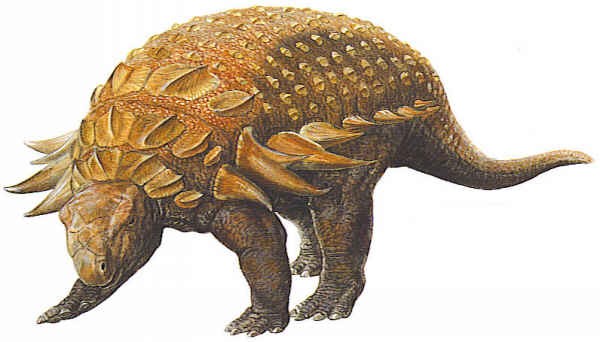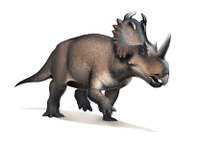Post by dinosauria101 on Jun 4, 2019 9:11:44 GMT 5
Panoplosaurus mirus
Panoplosaurus (meaning "completely armoured lizard") is a genus of nodosaurid dinosaur. It was one of the last known nodosaurids, living during the Late Cretaceous in what is now North America; fossils have been located in Alberta, Canada. The first fossil was found in 1917 by Charles M. Sternberg in Quarry 8, near Little Sandhill Creek. The type species Panoplosaurus mirus was named by Lawrence M. Lambe in 1919. The generic name is derived from Greek pan, "completely" and hoplon, "armour". The specific name means "wondrous" in Latin. Panoplosaurus was 5 to 7 metres (16 to 23 ft) long, around 2 metres (6.6 ft) tall, and had an estimated weight of 1.5–1.6 tonnes (1.7–1.8 short tons). It was heavily armoured, even by the standards of other nodosaurs, probably with traverse bands of studded plates covering its back and tail, although the tail likely lacked the club found in ankylosaurids. Larger paired ovals of bony armour covered the neck, shoulders and front limbs. These ovals were keeled, possessing a prominent curved ridge on the outer surface. Spikes on the shoulder, that some other nodosaurids featured, were absent. The armour on the head was fused into a compact helmet-like shield; these plates had a lumpy surface. Also bony cheek scutes were present.

Centrosaurus apertus
Centrosaurus ( /ˌsɛtrɵˈsɔrəs/ SEN-tro-SAWR-əs) is a genus of herbivorous ceratopsian dinosaurs from the late Cretaceous of Canada. Their remains have been found in the Dinosaur Park Formation and uppermost Oldman Formation, dating from 76.5 to 75.5 million years ago. The name Centrosaurus means "pointed lizard" (from Greek kentron/κεντρον = "point or prickle" + sauros/σαυρος = "lizard"), and refers to the series of small hornlets placed along the margin of their frills, not to the nasal horns (which were unknown when the dinosaur was named). The genus is not to be confused with the stegosaur Kentrosaurus, the name of which is derived from the same Greek word. The massive bodies of Centrosaurus were borne by stocky limbs, although at up to 18–20 ft (6m) they were not particularly large dinosaurs. Like other centrosaurines, Centrosaurus bore single large horns over their noses. These horns curved forwards or backwards depending on the species. A pair of small horns is also found over the eyes; in Centrosaurus apertus these are directed upwards, whereas they are directed to the sides in C. brinkmani. The frills of Centrosaurus were moderately long, with fairly large fenestrae and small hornlets along the outer edges. C. apertus is distinguished by having two large hornlets which hook forwards over the frill, while in C. brinkmani these hornlets are small and covered with small, finger-like growths.

Credit to Wikipedia
Panoplosaurus (meaning "completely armoured lizard") is a genus of nodosaurid dinosaur. It was one of the last known nodosaurids, living during the Late Cretaceous in what is now North America; fossils have been located in Alberta, Canada. The first fossil was found in 1917 by Charles M. Sternberg in Quarry 8, near Little Sandhill Creek. The type species Panoplosaurus mirus was named by Lawrence M. Lambe in 1919. The generic name is derived from Greek pan, "completely" and hoplon, "armour". The specific name means "wondrous" in Latin. Panoplosaurus was 5 to 7 metres (16 to 23 ft) long, around 2 metres (6.6 ft) tall, and had an estimated weight of 1.5–1.6 tonnes (1.7–1.8 short tons). It was heavily armoured, even by the standards of other nodosaurs, probably with traverse bands of studded plates covering its back and tail, although the tail likely lacked the club found in ankylosaurids. Larger paired ovals of bony armour covered the neck, shoulders and front limbs. These ovals were keeled, possessing a prominent curved ridge on the outer surface. Spikes on the shoulder, that some other nodosaurids featured, were absent. The armour on the head was fused into a compact helmet-like shield; these plates had a lumpy surface. Also bony cheek scutes were present.

Centrosaurus apertus
Centrosaurus ( /ˌsɛtrɵˈsɔrəs/ SEN-tro-SAWR-əs) is a genus of herbivorous ceratopsian dinosaurs from the late Cretaceous of Canada. Their remains have been found in the Dinosaur Park Formation and uppermost Oldman Formation, dating from 76.5 to 75.5 million years ago. The name Centrosaurus means "pointed lizard" (from Greek kentron/κεντρον = "point or prickle" + sauros/σαυρος = "lizard"), and refers to the series of small hornlets placed along the margin of their frills, not to the nasal horns (which were unknown when the dinosaur was named). The genus is not to be confused with the stegosaur Kentrosaurus, the name of which is derived from the same Greek word. The massive bodies of Centrosaurus were borne by stocky limbs, although at up to 18–20 ft (6m) they were not particularly large dinosaurs. Like other centrosaurines, Centrosaurus bore single large horns over their noses. These horns curved forwards or backwards depending on the species. A pair of small horns is also found over the eyes; in Centrosaurus apertus these are directed upwards, whereas they are directed to the sides in C. brinkmani. The frills of Centrosaurus were moderately long, with fairly large fenestrae and small hornlets along the outer edges. C. apertus is distinguished by having two large hornlets which hook forwards over the frill, while in C. brinkmani these hornlets are small and covered with small, finger-like growths.

Credit to Wikipedia


